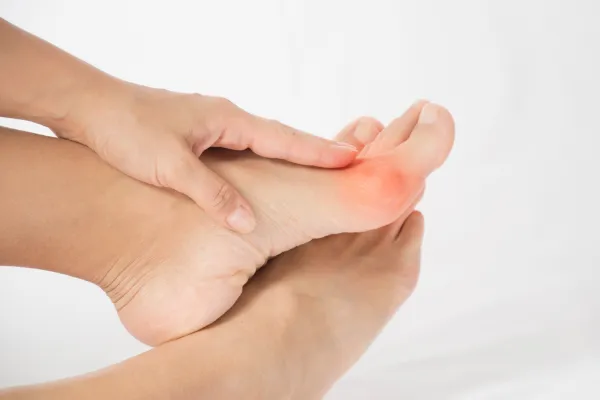Tips & Advice From Foot & Ankle Associates of Southern NH

The Role of Orthotics in Bunion Management
Bunions can be more than just a cosmetic issue; they often cause significant discomfort and affect your daily life. At Foot and Ankle Associates of Southern NH, we understand that managing bunions effectively involves a multi-faceted approach. One of the key tools in our management strategy is orthotics. Let’s explore how orthotics can play a crucial role in bunion management and how they can help you find relief.
What Are Bunions?
A bunion, or hallux valgus, is a bony bump that forms at the base of the big toe. It develops when the big toe leans toward the second toe, causing the joint at the base of the big toe to protrude. This misalignment can lead to pain, swelling, and difficulty in finding comfortable footwear.
How Orthotics Help Manage Bunions
Orthotics are custom-designed devices that are placed inside your shoes to correct abnormal foot mechanics and provide support. Here’s how they can assist in managing bunions:
Improving Foot Alignment
Orthotics are designed to realign the bones in your feet, particularly the big toe. By providing support and cushioning, orthotics help redistribute pressure away from the bunion and align the big toe more naturally. This can reduce the discomfort and slow the progression of the bunion.
Reducing Pain
Orthotics can help alleviate the pain associated with bunions by absorbing shock and providing cushioning. This can be particularly beneficial during activities that involve a lot of walking or standing, as they reduce the strain on the affected joint and the surrounding tissues.
Preventing Further Deformity
Custom orthotics can help prevent the bunion from worsening by providing proper support and correcting abnormal foot mechanics. This can help avoid additional complications such as hammertoes or metatarsalgia, which are often associated with bunions.
Enhancing Shoe Comfort
Finding comfortable shoes with bunions can be challenging. Orthotics can help make shoes more comfortable by adding extra cushioning and support. They can also help accommodate the bunion and reduce pressure points, making it easier to wear shoes without experiencing pain.
Providing Support and Stability
Orthotics offer additional support and stability to your feet, which can help balance your gait and reduce the stress placed on the bunion. This support is crucial in preventing further damage and ensuring that your feet function properly.
Types of Orthotics for Bunions
There are various types of orthotics designed to address different aspects of bunion management:
Custom Orthotics: These are tailor-made to fit the unique contours of your feet. They provide precise support and alignment for your specific needs. Custom orthotics are often recommended for individuals with severe bunion deformities or those who experience significant discomfort.
Over-the-Counter Orthotics: These pre-made inserts are designed to offer general support and cushioning. While not as specific as custom orthotics, they can still provide relief for mild to moderate bunion symptoms.
Bunion Pads: These are soft, cushioned pads that can be placed directly on the bunion to reduce friction and pressure. They are often used in conjunction with other types of orthotics to enhance comfort.
When to Consider Orthotics
Orthotics can be a valuable part of a comprehensive bunion management plan. Consider using orthotics if you experience:
Persistent pain or discomfort due to bunions
Difficulty finding comfortable shoes
Worsening symptoms despite conservative measures
A need for additional support and alignment
Other Management Strategies
While orthotics play a significant role in bunion management, they are often used alongside other strategies:
Footwear Modifications: Choose shoes with a wide toe box and good arch support to accommodate the bunion and reduce pressure.
Padding and Cushioning: Use gel pads or cushions to protect the bunion and relieve pain.
Exercise and Stretching: Perform exercises to strengthen and stretch the foot muscles, which can improve alignment and reduce discomfort.
Medical Consultation: Regular check-ups with a podiatrist can help monitor the condition and adjust your treatment plan as needed.
Conclusion
Orthotics can be an effective solution for managing bunions and improving your overall comfort. By providing support, reducing pain, and preventing further deformity, orthotics play a crucial role in a comprehensive bunion management plan. If you’re struggling with bunion pain or discomfort, consult with the experts at Foot and Ankle Associates of Southern NH. Our team can help you find the right orthotic solution and develop a personalized treatment plan to get you back on your feet comfortably. Schedule a consultation today and take the first step toward better foot health!
Ask Foot & Ankle Associates of Southern NH And Their Team
Fill in the form to request a call from our team. One of our team members will call you for FREE and answer any questions or concerns you may have about your condition
Where To Find Foot & Ankle Associates of Southern NH

If you have any questions before scheduling an appointment or for general inquiries, please use the contact us button below. Our team will promptly reach out to assist you.
Opening Hours
Monday: 8:00am – 5:00pm
Tuesday: 8:00am – 5:00pm
Wednesday: 8:00am – 2:00pm
Thursday: 8:00am – 5:00pm
Friday: 8:00am – 2:00pm
Saturday: Closed
Sunday: Closed

